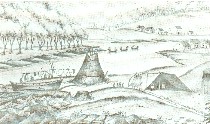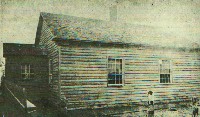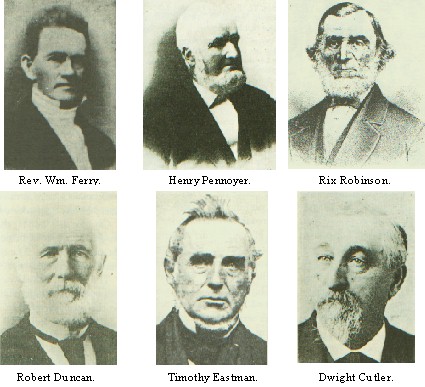
Henry Griffin.
The Evening Tribune September, 1891
Our History
The Grand River Times September, 1851 issue, except for the Marine List, was omitted from this section for lack of sufficient local news content. This excellent 1873 article about the very early history of Grand Haven and Ottawa County was used instead.
Early Life in Grand Haven,
and Ottawa County.

Henry Griffin.
At the usual weekly social gathering of the ladies of the Presbyterian church in this city on Thursday evening last, at the residence of H. C. Akeley, Esq. Mr. Griffin entertained the company with a brief address consisting mainly of reminiscences of the early settlement of the city and county. We are permitted to copy it nearly entire. On being introduced, Mr. Griffin said:
Ladies and Gentlemen: Having accepted the invitation to address you on this occasion, I make no apology for appearing before you. And if I can say anything acceptable to this intelligent audience on the subject assigned—the early settlement of our city and county—I shall be gratified. I propose therefore in a familiar manner to give you some account of the enjoyments, the privations and the hardships of thirty-odd years ago.
We sometimes had social gatherings in that day—if only a few families. If you would have looked in upon one of these, at the house of Mr. Benjamin Hopkins, at Scranton—now Eastmanville—you would have seen some things which you are not familiar. The old style Dutch fireplace—bright and cherry on a winter night—with the logs of hickory or maple piled on as to get rid of them. Uncle Benjamin and his sons, even down to little "Mort," Dr. Eastman, and myself, were discussing history, politics, or religion. And the ladies—most of whom are now passed away to their reward—were listening, or chatting, or singing. The widow of Capt. Allen was there, the good old lady, small in stature herself, but who could tell you her husband was not only a handsome man, but weighed 200 pounds.
We were without roads or bridges in those days, traveled in primitive style, paddling our own canoes, or treading the Indian trails in summer, or on the ice in the winter. Instead of the usual mode of hauling a barrel of flour on a hand sled on the ice, Mr. J. Vincent Hopkins, then a boy, and myself at one time to get a grist of Capt. Robert Howlet’s wheat crop at Grandville, and have it ground at the Grandville mill, then just started. It required a whole week to accomplish this 20 miles and get the grist home, going twice. We traveled about 100 miles to do this. We lost our way in a snow storm in the woods, got a ducking in Deer creek, and almost froze to death in consequence.

Early Grand Rapids.
My first visit to Grand River, was in August, 1837. At Detroit I first met Silas G. Harris, the brother of Capt. I. V. Harris, whom I see here tonight. We were eight days traveling to Grand Rapids, where we arrived wet from head to foot, having been caught out in a violent storm. We found there one hotel kept by Mr. Morean and called for supper and a bed.—Our bill of fare was sour black bread, something called a cup of tea, and fried rancid pork. Our sleeping room contained about 30 persons, and a swarm of mosquitoes. Next morning, we took a look at the town. We found an Indian encampment on the west side, and Godfey’s warehouse and James Watson’s store on the east side. Here I first met Mr. Ebenezer Barns, a clerk, and since for many years a resident here. The store was well filled with Indian goods. The white population was very small, and there was scarcely one regular street in the village, where now exists a population of 20,000 inhabitants.
Taking the steamer Gov. Mason, then just built, we laid our course down the river. Touching at Grandville, we found Mr. Osgood, an attorney, and Mr. Balke ina a new hotel and store.—We passed Widow Burton’s, and stopped at Sand Creek, where I first met Capt. I. V. Harris. At Lamont we found one log shanty, occupied by Mr. Yoemans. Stopping at what was then called Scranton (Eastmanville) I found Mr. Benjamin Hopkins. He had made a pre-emption, as the land was not yet in market on the north side of the river, he had got a small clearing made, and a fine garden under cultivation. As this was near the geographical center of the county, it was thought it would become the County seat. I purchased a pre-emption adjoining that of Mr. Hopkins, and built a house, with the purpose of making Michigan my future home. I then went east, and the following spring embarked at Buffalo with my family on board the steamer Columbus, Capt. Walker, with 60 cabin passengers, and about 100 Swiss in the steerage, going to Green Bay. We were twelve days in beautiful weather in making the passage to Grand Haven, and landed here on the first day of June, 1838.—Milwaukee had then 500 inhabitants.—We called on Rev. William M. Ferry, and went up the river to Scranton, on board the steamer Owashtenonk, Capt. T. W. White. Mrs. White, and Miss Mary A. White were fellow passengers.
The timber along the river bottoms was very large, and many trees measured six feet at the stump were cut for pipe staves for the Buffalo market.
In the summer season, there was always something enchanting in a life in the woods. The great variety of wild flowers along the banks of the river, added beauty, and the birds of song, melody to the scene. Deer were frequently seen bounding through the forest and "the wolf’s long howl" was heard at night.
The trade and commerce of Grand Haven were then very small. At first the pole boats, propelled by men did the business. Then followed the Steamers Owashtenonk, Gov. Mason, Mishawaukee, Algoma, Daniel Ball, Olive Branch, and Jenison. The lumber vessels were very small. Many remember the old St. Joseph, Capt. Peterson; Cook, Capt. Noyes; Caroline, Capt. Harry Miller; Pioneer, Capt. Chaloner; Reindeer, the New Hampshire, Capt. Warren; the Vermont, and others. Subsequently the brig Enterprise was built by Jabez Barber, who was lost at seas in the ill-fated Pacific. The Lizzie Throop, Illinois, Magic, Telegraph, Amanda, and Pearson followed—a fine class of lumber vessels.
The first mill built in this county was at Grand Haven; built by Hathaway & Butts. It was a small affair, afterwards owned and enlarged by Nathan Throop. Later it was owned by F. B. Gilbert & Co., by Ferry & Son, and by Wyman, Buswell, & Co. It underwent several enlargements by these several proprietors. It was recently burned, and its site is now occupied by the splendid freight and passenger depots of the D. & M. Rail Road.
The first Judges before and after our county was organized, were Judge Wipple and Judge Ransom.
The first attorneys who permanently located here were Robert W. Duncan, and Moses B. Hopkins. Messrs. Wm. H. Parks and Grosvenor Reed were here at an early day, but did not remain.

Second St. School House.
The first Lyceum organized at Grand Haven held its meetings in the old school house on Second Street, Hon. Henry Pennoyer, President. T. W. Ferry, M. B. Hopkins, George Torrey, (now a clergyman in Vermaont) and many others, here contested the palm of victory in many of well fought field of intellectual struggle. Hon. T. W. Ferry’s first great success here was his eulogy of John Quincy Adams.
Miss Mary A. White taught the first day school and first Sunday school in this same old school house. In one of the day schools, E. P. Ferry, then about seven years of age, made his maiden speech, "Sink or swim, live or die, survive or perish, I give my hand to this measure." And little Johnny Pennoyer his "Tall oaks from little acorns grow."
The only business done at Spring Lake in 1837 was T. D. Gilbert’s pine cord wood business, to supply Buffalo steamers, calling occasionally in this harbor. Ferrysburg had only an Indian encampment. Now they are enterprising villages, rapidly increasing in wealth and population.

The first clergyman settled at Grand Haven was Rev. Wm. Ferry, who was also the first white settler in the County His connection with the settlement and progress of this city and County is so familiar to us all that we need not dwell upon it.
The first physician here was Dr. Williams, of the firm of Robinson, White & Williams, of more than thirty years since. Dr. Timothy Eastman also came here at an early day, and afterward became our County Judge. Dr. Stephen Monroe came a few years after and yet remains with us.
The now venerable Rix Robinson was the first fur trader, coming here in 1825, and for some time lived in a dwelling on a lot which I now reside.—William Lasley and Pierre C. Duverney were also traders here with the Indians. Soon after Mr. Ferry’s arrival a vessel came into our harbor with forty-two Robinsons on board, all of whom settled on Grand River.
Capt. Harry Miller, while sailing the brig Manhattan, came into our harbor in 1833. He says a miserable looking craft from Buffalo lay against the bank, in charge of a man named White. When asked how he dare come around the lakes in that thing, he replied, "Oh she is a better ship than Columbus had to cross the ocean in." She was afterwards called the Spitfire.
The first good dwelling houses built were by Rev. Wm. M. Ferry, on the corner of Washington and Water streets, since burned; David Carver, now the residence of William Wallace; Dr. Williams, now the residence of George Parks; and C. B. Albee, now owned by Galen Eastman.
The first store, warehouse and dock was that of Robinson, White and Williams, for whom F. B. Gilbert was clerk. This was the only one doing much business for many years. Messrs. Ferry, C. B. Albee, and F. B. Gilbert, each subsequently built on Washington Street.
The first dry goods store on Washington Street, was that of S. C. Hopkins & Co., who, in 1847 removed to Spring Lake. The first permanent general store on Washington Street was built by myself in 1849, and is now occupied by me.
In 1844, there was not a regular street in Grand Haven. You crooked around among the stumps and across lots to go anywhere.
The only public building we had for all purposes, school house, court house, town house and church, was the old 24x36 school house on Second Street.